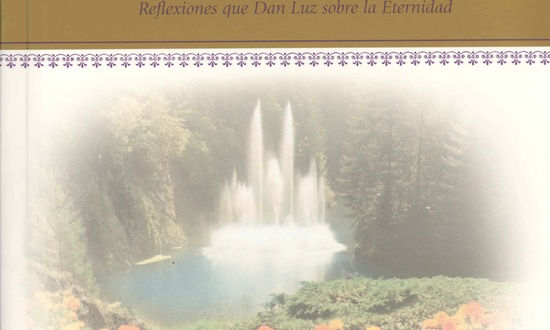Veo el cielo abierto, y al Hijo del hombre de pie a la derecha de Dios. — Hechos 7:56
Dentro de poco van a leer en el periódico que he muerto. No lo crean ni por un instante. Estaré más vivo que nunca antes. . . . La Tierra se desvanece. . . . ¡El cielo se abre ante mí! [1] — D. L. Moody, en su lecho de muerte
Cuando morimos, nuestros cuerpos van a la tierra, mientras que nuestros espíritus dejan este mundo y van a otro. “Volverá entonces el polvo a la tierra, como antes fue, y el espíritu volverá a Dios, que es quien lo dio” (Eclesiastés 12:7).
Cuando sale del cuerpo, el espíritu humano va al Cielo o al Infierno. Jesús describió a Lázaro y al hombre rico como conscientes en el Cielo y el Infierno inmediatamente después que murieron (Lucas 16:19-31). Varios pasajes dejan claro que no hay tal cosa como un “sueño del alma,” o un largo período de inconsciencia entre la vida en la Tierra y la vida en el Cielo. Jesús le dijo al ladrón que moría en la cruz: “Hoy estarás conmigo en el paraíso” (Lucas 23:43). El apóstol Pablo dijo que morir era estar con Cristo (Filipenses 1:23), y que estar ausente del cuerpo era estar presente con el Señor (2 Corintios 5:8). Después de su muerte, los mártires son descritos en el Cielo, clamando a Dios para traer justicia a la Tierra (Apocalipsis 6:9-11).
La frase los que duermen (en 1 Tesalonicenses 4:13, RV60, y pasajes similares) es un eufemismo para la muerte que describe la apariencia exterior del cuerpo. La partida del espíritu del cuerpo termina nuestra existencia en la Tierra. Nuestra parte física “duerme” hasta la resurrección, mientras que nuestra parte espiritual se traslada a una existencia consciente en el Cielo (Daniel 12:2-3; 2 Corintios 5:8). Todas las referencias en Apocalipsis a seres humanos que hablan y adoran en el Cielo antes de la resurrección de los muertos demuestran que nuestros seres espirituales están conscientes, no durmiendo, después de la muerte.
El Cielo presente generalmente es invisible para los que viven en la Tierra. Pero esto no significa que no es un lugar físico. Y aun si no es físico, eso no quiere decir que no es real. La Biblia enseña que algunas veces a los seres humanos se les permite ver el Cielo. Cuando estaban apedreando a Esteban por causa de su fe en Cristo, “fijó la mirada en el cielo y vio la gloria de Dios, y a Jesús de pie a la derecha de Dios. ‘¡Veo el cielo abierto,’ exclamó, ‘y al Hijo del Hombre de pie a la derecha de Dios!’” (Hechos 7:55-56). Las Escrituras nos dicen que Esteban no lo soñó, sino que realmente lo vio. Dios no creó una visión para hacer que el Cielo pareciera físico, sino que permitió que Esteban viera el Cielo presente, que era (y es) físico.
El profeta Eliseo le pidió a Dios que le diera a su siervo Guiezi una vislumbre del reino invisible. “Eliseo oró: ‘Señor, ábrele los ojos a Guiezi para que vea.’ El Señor así lo hizo, y el criado vio que la colina estaba llena de caballos y de carros de fuego alrededor de Eliseo” (2 Reyes 6:17). Se podría argumentar que esos caballos y carros (con guerreros angelicales) existen al lado nuestro en nuestro universo, pero que normalmente no los vemos. O pueden estar en un universo al lado del nuestro que se abre en el nuestro para que los seres angelicales—y los caballos, aparentemente—se puedan mover entre los universos.
El texto deja claro que Esteban y Guiezi vieron cosas que eran realmente físicas. Esto apoya el punto de vista de que el Cielo es un reino físico. Físico y espiritual no son ni opuestos ni contradictorios. El apóstol Pablo se refiere al cuerpo resucitado como un “cuerpo espiritual” (1 Corintios 15:44). Dios es espíritu, y los ángeles son seres espirituales, y ambos pueden—y lo harán en la Nueva Tierra—vivir en un ambiente físico.
Si un ciego recobrara la vista momentáneamente y viera un árbol real y lo describiera, otros ciegos—especialmente si vivieran en un mundo donde todos son ciegos—podrían asumir automáticamente que el árbol no es literal. Podrían pensar que la descripción del árbol es un simple símbolo de alguna realidad espiritual, pero estarían equivocados. De la misma forma, no deberíamos asumir que la Biblia describe al Cielo de maneras físicas sólo para complacernos.
Las descripciones bíblicas del Cielo presente dan la impresión de que es un reino físico, por lo menos en algún sentido. Pero ya sea físico o no, el Cielo presente por cierto que es real. Es un lugar al que vamos, un lugar en el cual estaremos con Dios y sus hijos, un lugar sin pecado y sin sufrimiento.
¿No es eso algo que anhelar todos los días de su vida?
Señor, tú nos has creado para que seamos personas que desean un lugar. Gracias porque cuando muramos iremos a nuestro hogar para estar contigo. Gracias porque hay un lugar real que nos está esperando. Gracias porque la sangre de Jesús provee los medios para nuestra entrada, y porque muchos de tus hijos ya han ido allí antes que nosotros. Te alabamos por las maravillas de tu amor, el cual no merecemos, pero que recibimos con alegría y gratitud.
[1] George Sweeting y Donald Sweeting, “The Evangelist and the Agnostic [El Evangelista y el Agnóstico],” Moody Monthly ( Julio/Agosto 1989), 69.
The Present Heaven: A Physical Place?
I see heaven open and the Son of Man standing at the right hand of God. —Acts 7:56
Soon you will read in the newspaper that I am dead. Don’t believe it for a moment. I will be more alive than ever before. . . . Earth recedes. . . . Heaven opens before me! [1] —D. L. Moody, on his deathbed
At death, our bodies go to the ground, while our spirits leave this world and go to another. “The dust returns to the ground it came from, and the spirit returns to God who gave it” (Ecclesiastes 12:7).
When leaving the body, the human spirit goes to either Heaven or Hell. Jesus depicted Lazarus and the rich man as conscious in Heaven and Hell immediately after they died (Luke 16:22-31). A number of other passages make it clear that there is no such thing as “soul sleep,” or a long period of unconsciousness between life on Earth and life in Heaven. Jesus told the dying thief on the cross, “Today you will be with me in paradise” (Luke 23:43). The apostle Paul said that to die was to be with Christ (Philippians 1:23) and to be absent from the body was to be present with the Lord (2 Corinthians 5:8). After their deaths, martyrs are pictured in Heaven, crying out to God to bring justice on Earth (Revelation 6:9-11).
The phrase fall asleep (in 1 Thessalonians 4:13 and similar passages) is a euphemism for death, describing the body’s outward appearance. The spirit’s departure from the body ends our existence on Earth. The physical part of us “sleeps” until the resurrection, while the spiritual part of us relocates to a conscious existence in Heaven (Daniel 12:2-3; 2 Corinthians 5:8). Every reference in Revelation to human beings talking and worshiping in Heaven prior to the resurrection of the dead demonstrates that our spiritual beings are conscious, not sleeping, after death.
The present Heaven is normally invisible to those living on Earth. But this doesn’t mean it isn’t physical. And even if it isn’t physical, that doesn’t mean it isn’t real. The Bible teaches that sometimes humans are allowed to see into Heaven. When Stephen was being stoned because of his faith in Christ, he “looked up to heaven and saw the glory of God, and Jesus standing at the right hand of God. ‘Look,’ he said, ‘I see heaven open and the Son of Man standing at the right hand of God’ ” (Acts 7:55-56). Scripture tells us that Stephen did not dream this but actually saw it. God didn’t create a vision for Stephen in order to make Heaven appear physical. Rather, he allowed Stephen to see an intermediate Heaven that was (and is) physical.
The prophet Elisha asked God to give his servant, Gehazi, a glimpse of the invisible realm. He prayed, “‘O Lord, open his eyes so he may see.’ Then the Lord opened the servant’s eyes, and he looked and saw the hills full of horses and chariots of fire all around Elisha” (2 Kings 6:17). It could be argued that these horses and chariots (bearing angelic warriors) exist beside us in our universe, but we are normally blind to them. Or they may be in a universe next to ours that opens up into ours so that angelic beings—and horses, apparently—can move between universes.
The text is clear that Stephen and Gehazi saw things that were actual and physical. This supports the view that Heaven is a physical realm. Physical and spiritual are neither opposite nor contradictory. In fact, the apostle Paul refers to the resurrection body as a “spiritual body” (1 Corinthians 15:44). God is a spirit and angels are spirit beings, but both can—and will on the New Earth—live in a physical environment.
If a blind man momentarily gained his sight and described an actual tree that he saw, other blind people—especially if they lived in a world where everyone was blind—might automatically assume the tree was not literal. They might think the description of the tree was a mere symbol of some spiritual reality. But they would be wrong. Likewise, we should not assume that the Bible describes Heaven in physical ways merely to accommodate us.
The biblical portrayals of the present Heaven make it seem likely that it is a physical realm, at least in some sense. But whether or not it is physical, the present Heaven is certainly real. It is a real place we go to—a place where we will be with God and his people, a place without sin and without suffering.
Isn’t that something to look forward to every day of your life?
Lord, you have made us to be people who desire a place. Thank you that at death we will go home to be with you. Thank you that there is a real place awaiting us. Thank you that the blood of Jesus provides the means for our entrance and that many of your people have gone there before us. We praise you for the wonders of your love, which we do not deserve but which we gladly and gratefully receive.
[1] George Sweeting and Donald Sweeting, “The Evangelist and the Agnostic,” Moody Monthly (July/August 1989), 69.
Photo by Mark Harpur on Unsplash



